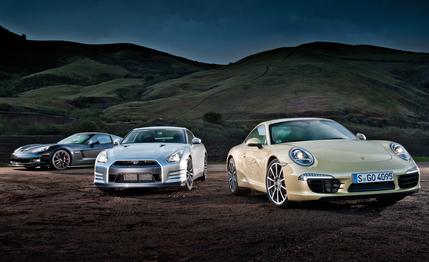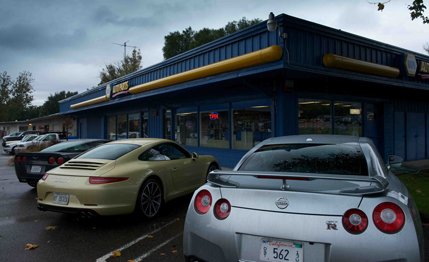 Comparison Tests
Comparison Tests
 TESTED
TESTED
The cuckoo clock in Zuffenhausen struck high noon recently and out popped a new 911, an event so freighted with anticipation by our little community that we lay in extra supplies of ink and binding glue for its arrival.
It’s all (okay, mostly) new. It’s been pulled out at the wheelbase and bumpers and pushed down at the roof, and it has aluminum in spots where steel once served. Maybe you have to squint to see the visual differences from its predecessor, but why would you expect anything else? A 911 must look like a 911 or—well, we don’t actually know the answer to “or what” because Porsche isn’t interested in finding out.
If you’re shopping the new 991-series Carrera S—which is denoted in our pricing software as the “New Coupe Carrera S,” as opposed to the old 997-series Carrera S that is being sold alongside it, both as 2012 models—you’re probably not among the Occupy Wall Street set; still, you’re less likely to be in the top one percent of earners than perhaps in the top 10 percent. The same goes for the other cars here: a 505-hp Chevrolet Corvette Z06 with an astonishing price tag to match its astonishing performance, and Nissan’s aero-android GT-R, with 15 more horsepower for 2013 on top of the 45 it received for 2012.

To the left, right, and center of $100K, this trio is expensive but still attainable if you're weathering the recession filing legal briefs, performing angioplasty, or just giving your best to The Man. Until just recently, the sports-car sweet spot was about $20K more affordable, and part of this tale is of an industry trend that, following airline tickets, gives you a couple of seats for one price while charging extra for a lot of the good stuff.
Take our Corvette. You get the 7.0-liter LS7 engine, the Z06 suspension, and two lumpy buckets for $76,500. Another $8815 puts you in the 3LZ package, which buys vastly improved power sport seats, plus a premium Bose stereo, power tilting/telescoping steering, head-up display, leather-wrapped dash, and some other frills. The Ultimate Performance package adds Brembo carbon-ceramic brakes, ZR1 carbon-fiber bits, and Michelin Pilot Sport Cup run-flat tires. Price: $11,495.
The Centennial Special Edition decals and logos celebrating Chevy’s 100th birthday, plus one thing we wouldn’t buy a Vette without, Magnetic Selective Ride Control, retail for $5345 (if you’re not feeling celebratory, you can get the magnetorheological shocks alone for $2495). Options total: $25,655, or one-third of the car’s base price.
The Ben Franklins fly even faster in Porsche’s showroom. The Carrera S’s Premium package with power seats costs $2940. Hydraulically adjusted anti-roll bars combined with electronic damping control: $4050. The sport exhaust: $2950. Black, red, white, and yellow are the no-cost exterior colors; our Lime Gold Metallic hue runs $3140. Carbon-ceramic brakes cost $8520 here. And so on. Options total: $33,900, or 35 percent of the base price.
Hey, we’d rather be talking about torque curves and lift-throttle oversteer, but today’s pricing strategies oblige us to devote space to making sense of the dollars. One outlier is the 2013 twin-turbo Nissan GT-R. The base price is expected to be about $92,500 once Nissan finally discloses it, and there are few options. In 2012, the GT-R extras were Super Silver paint, a backup camera, and logo-embroidered floor mats. That’s it. (We had none of those options on our car.) The ’13s, which have improved shift feel, the factory claims, plus the 15 extra horses, aren’t likely to be much different.
In our comparison test, three different cars with three different driveline configurations resulting from three different design philosophies hailing from three different nations can still produce only one winner.